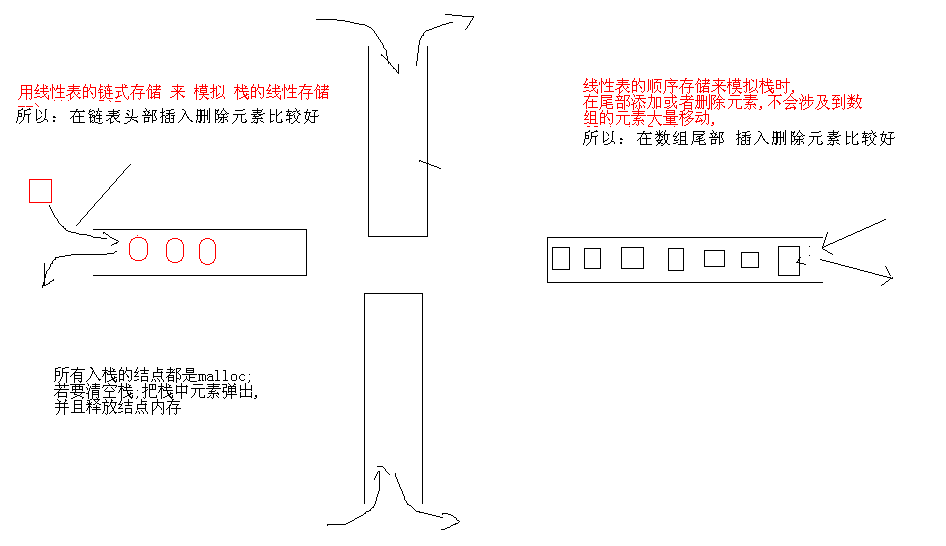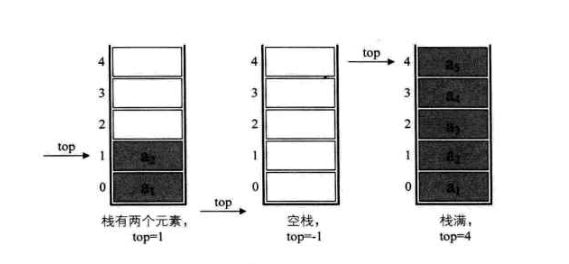Stack基本概念
栈是一种 特殊的线性表
栈仅能在线性表的一端进行操作
栈顶(Top):同意操作的一端
栈底(Bottom):不同意操作的一端
Stack的经常使用操作
创建栈
销毁栈
清空栈
进栈
出栈
获取栈顶元素
获取栈的大小
栈模型和链表模型关系分析
栈的顺序存储设计与实现
// seqlist.h
// 顺序存储结构线性表的API声明
#ifndef __MY_SEQLIST_H__
#define __MY_SEQLIST_H__
typedef void SeqList;
typedef void SeqListNode;
//链表 创建
SeqList* SeqList_Create(int capacity);
//链表 销毁
void SeqList_Destroy(SeqList* list);
链表 清空
void SeqList_Clear(SeqList* list);
//链表 长度
int SeqList_Length(SeqList* list);
//链表 容量
int SeqList_Capacity(SeqList* list);
//链表 在某一个位置 插入元素
int SeqList_Insert(SeqList* list, SeqListNode* node, int pos);
//获取某一个位置的链表结点
SeqListNode* SeqList_Get(SeqList* list, int pos);
//删除某一个位置的结点
SeqListNode* SeqList_Delete(SeqList* list, int pos);
#endif //__MY_SEQLIST_H__// seqList.cpp
// 顺序存储结构的栈API实现
#include <iostream>
#include <cstdio>
#include "seqlist.h"
using namespace std;
typedef struct _tag_SeqList
{
int capacity;
int length;
int **node;
}TSeqList;
//链表 创建
SeqList* SeqList_Create(int capacity)
{
int ret = -1;
TSeqList *tmp = NULL;
tmp = (TSeqList *)malloc(sizeof(TSeqList));
if (tmp == NULL) {
ret = 1;
printf("function SeqList_Create() err:%d\n", ret);
return NULL;
}
memset(tmp, 0, sizeof(TSeqList));
tmp->capacity = capacity;
tmp->length = 0;
tmp->node = (int **)malloc(sizeof(void *) * capacity);
if (tmp->node == NULL) {
ret = 2;
printf("function SeqList_Create() err:%d\n", ret);
return NULL;
}
memset(tmp->node, 0, sizeof(void *) * capacity);
return tmp;
}
//链表 创建
int SeqList_Create2(int capacity, SeqList**handle)
{
int ret = 0;
TSeqList *tmp = NULL;
tmp = (TSeqList *)malloc(sizeof(TSeqList));
if (tmp == NULL)
{
ret = 1;
printf("func SeqList_Create2() err :%d \n", ret);
return ret;
}
memset(tmp, 0, sizeof(TSeqList));
tmp->capacity = capacity;
tmp->length = 0;
tmp->node = (int **)malloc(sizeof(void *) * capacity);
if (tmp->node == NULL)
{
ret = 2;
printf("func SeqList_Create2() malloc err :%d \n", ret);
return ret;
}
*handle = tmp;
return ret;
}
//链表 销毁
void SeqList_Destroy(SeqList* list)
{
if (list == NULL) {
return;
}
TSeqList *tmp = (TSeqList *)list;
if (tmp->node != NULL) {
free(tmp->node);
}
free(tmp);
return;
}
链表 清空
void SeqList_Clear(SeqList* list)
{
if (list == NULL) {
return;
}
TSeqList *tmp = (TSeqList *)list;
tmp->length = 0;
memset(tmp->node, 0, sizeof(tmp->node));
return;
}
//链表 长度
int SeqList_Length(SeqList* list)
{
if (list == NULL) {
return -1;
}
TSeqList *tmp = (TSeqList *)list;
return tmp->length;
}
//链表 容量
int SeqList_Capacity(SeqList* list)
{
if (list == NULL) {
return -1;
}
TSeqList *tmp = (TSeqList *)list;
return tmp->capacity;
}
//链表 在某一个位置 插入元素
int SeqList_Insert(SeqList* list, SeqListNode* node, int pos)
{
if (list == NULL || node == NULL || pos < 0) {
return -1;
}
TSeqList *tList = (TSeqList *)list;
// 假设满了
if (tList->length >= tList->capacity) {
return -2;
}
// 假设pos的位置超出了length。即中间空了一些位置
if (pos > tList->length) {
pos = tList->length;
}
for (int i = tList->length; i > pos; --i) {
tList->node[i] = tList->node[i - 1];
}
tList->node[pos] = (int *)node;
++tList->length;
return 0;
}
//获取某一个位置的链表结点
SeqListNode* SeqList_Get(SeqList* list, int pos)
{
TSeqList *tList = (TSeqList *)list;
if (list == NULL || pos < 0 || pos >= tList->length)
{
return NULL;
}
SeqListNode *tListNode = NULL;
tListNode = (int *)tList->node[pos];
return tListNode;
}
//删除某一个位置的结点
SeqListNode* SeqList_Delete(SeqList* list, int pos)
{
TSeqList *tList = (TSeqList *)list;
SeqListNode *tListNode = NULL;
if (list == NULL || pos < 0 || pos >= tList->length) {
return NULL;
}
tListNode = tList->node[pos];
for (int i = pos + 1; i < tList->length; ++i) {
tList->node[i - 1] = tList->node[i];
}
--tList->length; // 别忘了长度减一
return tListNode;
}// seqstack.h
// 顺序存储结构的栈API声明
#ifndef __SEQSTACK_H__
#define __SEQSTACK_H__
typedef void SeqStack;
// 创建栈
SeqStack* SeqStack_Create(int capacity);
// 销毁栈
void* SeqStack_Destroy(SeqStack* stack);
// 清空栈
void* SeqStack_Clear(SeqStack* stack);
// 元素入栈
int SeqStack_Push(SeqStack* stack, void* item);
// 弹出栈顶元素
void* SeqStack_Pop(SeqStack* stack);
// 获取栈顶元素
void* SeqStack_Top(SeqStack* stack);
// 获取栈的大小
int SeqStack_Size(SeqStack* stack);
// 获取栈的容量
int SeqStack_Capacity(SeqStack* stack);
#endif// seqstack.cpp
// 顺序存储结构栈的API实现
// 调用了之前写好的顺序链表API
#include <cstdio>
#include "seqlist.h"
#include "seqstack.h"
// 创建栈,相当于创建一个线性表
SeqStack* SeqStack_Create(int capacity)
{
return SeqList_Create(capacity);
}
// 销毁栈。相当于销毁链表
void* SeqStack_Destroy(SeqStack* stack)
{
SeqList_Destroy(stack);
return NULL;
}
// 清空栈,相当于清空链表
void* SeqStack_Clear(SeqStack* stack)
{
SeqList_Clear(stack);
return NULL;
}
// 元素入栈,相当于在线性表(数组)的尾部加入元素
int SeqStack_Push(SeqStack* stack, void* item)
{
return SeqList_Insert(stack, item, SeqList_Length(stack));
}
// 弹出栈顶元素,相当于从线性表的尾部删除元素
void* SeqStack_Pop(SeqStack* stack)
{
return SeqList_Delete(stack, SeqList_Length(stack) - 1);
}
// 获取栈顶元素。相当于获取链表的尾部元素
void* SeqStack_Top(SeqStack* stack)
{
return SeqList_Get(stack, SeqList_Length(stack) - 1);
}
// 获取栈的大小。相当于获取链表的长度
int SeqStack_Size(SeqStack* stack)
{
return SeqList_Length(stack);
}
// 获取栈的容量
int SeqStack_Capacity(SeqStack* stack)
{
return SeqList_Capacity(stack);
}// main.cpp
// 顺序结构栈的測试程序
#include <stdio.h>
#include "seqstack.h"
void play()
{
int i = 0;
SeqStack *stack = NULL;
int a[10];
for (i = 0; i < 10; ++i) {
a[i] = i + 1;
}
stack = SeqStack_Create(20);
// 入栈
for (int i = 0; i < 5; ++i) {
SeqStack_Push(stack, &a[i]);
}
printf("len:%d \n", SeqStack_Size(stack));
printf("capacity:%d \n", SeqStack_Capacity(stack));
printf("top:%d \n", *((int *)SeqStack_Top(stack)));
// 元素出栈
while (SeqStack_Size(stack)) {
printf("%d ", *((int *)SeqStack_Pop(stack)));
}
SeqStack_Destroy(stack);
return;
}
int main()
{
play();
return 0;
}project代码详情:Github
























 1484
1484











 被折叠的 条评论
为什么被折叠?
被折叠的 条评论
为什么被折叠?








